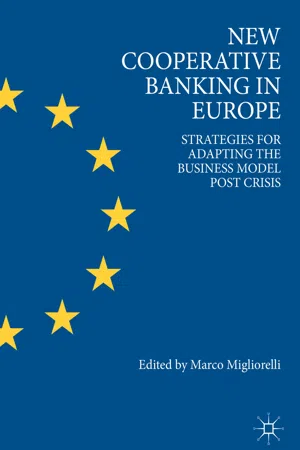1.1 Cooperative Banks: Origins and Fundamental Principles in Today’s World
Cooperation is a crucial behavioural principle of human social life (Rilling et al. 2002; Gintis et al. 2004), and it is key to our survivorship (Harari 2012). Considering that natural selection is based on the success of the single individual, the explanation of the existence of social cooperation among nonrelatives has long been a dare for evolutionary biologists. Despite the progress on this apparent paradox, the question on how the cooperative behaviour evolved can still be considered one of the 25 most challenging interrogatives that researchers will have to deal with (Pennisi 2005). There are several advantages associated with cooperation. Firstly, cooperation positively affects the efficiency of the production process, quantitatively increasing the resource production capabilities. Secondly, it increases the variety and the quality of goods and services individuals can acquire. Thirdly, in a fluctuating environment as the world we live in, cooperation represents an insurance against variability (Barker et al. 2017).
In the first half of the nineteenth century, in Germany , Friedrich Wilhelm Raiffeisen perceived these advantages and understood that a way to fight the poverty spread among rural population was to foster people to help themselves. The Stein-Hardenberg Reforms in the agriculture sector, which led to the so-called bauernbefreiung (peasant liberation), had the effect to create a new social context characterised by the free circulation of people and the increased availability of the labour force. If, on the one hand, the process of liberalisation of the farmers had the consequences of enriching opportunities in the agriculture sector as a whole thanks to an increase of the productivity rate, on the other hand, it caused higher unemployment, in particular in remote rural areas. This, in addition to the gewerbefreiheit (freedom of trade), which eliminated the protection insured by corporations, caused a widespread impoverishment of farmers, whose life conditions worsen remarkably. In this situation of misery and dissatisfaction of a large part of the population, Friedrich Wilhelm Raiffeisen realised that the core of the problem had to be addressed to the lack of adequate capital in the rural environment. He believed that to interrupt the vicious circle by which the inadequacy of available monetary resources generated even more misery, the rural system had to rely on the opportunities within the system, applying the selbsthilfe (self-help) principle, rather than struggle to collect resources from the outside (Raiffeisen 1866).
While the dissolution of the ancient feudal system was impoverishing inhabitants of the rural areas, the industrial revolution that mainly concerned urban and suburban locations undermined the stability of small businesses and craftsmen, who needed working capital and fresh resources to renew their activities. Independently from Raiffeisen , Franz Hermann Schulze-Delitzsch proposed the view by which the individual improves his conditions relying on his own initiative and, whenever his effort would not be sufficient to overcome difficulties, joining forces and cooperation would promote the success (Tamagnini 1960).
At that time, credit institutions were lending only large amounts of resources backed by collaterals and the existing credit system was not adequate to provide for the new financial needs of farmers and artisans in rural and urban areas respectively. It was in this climate of difficulties that, in Germany , the two personalities of Raiffeisen and Schulze-Delitzsch, even if with different political and social views,1 found a humus to conceive the modern cooperative credit system. The common aim was to improve the life conditions of a large part of population that, from the ongoing socio-economic, political and technological changes was obtaining only alienation and misery. Besides sharing the so-called mutualist model, the Raiffeisen and Schulze-Delitzsch cooperative banks exhibited several operative differences. Raiffeisen ’s cooperatives were located in rural and small urban areas and their activity was confined to narrow districts, the parish, in order to ensure that individual members knew each other well. The structure was a solidarity-based liability of all the members for possible debts (one for all—all for one) and, except for the treasurer who was paid a salary, the administrative roles were carried on an honorary basis. The loans granted were long term, the involvement with non-credit activities was permitted and no dividends were paid on shares. Schulze-Delitzsch’s cooperative banks , instead, were located in urban areas and admitted as members people living in the city or in part of it. Opposite to the Raiffeisen ’s model, in the Schulze-Delitzsch’s model liability was limited, managers (and not exclusively treasurers) were paid, short-term loans were granted with the possibility of renewals, non-credit activities were permitted and dividends were paid on shares. In a few decades, starting from Germany, Raiffeisen and Schulze-Delitzsch’s models spread rapidly across neighbouring countries. Nevertheless, historical aspects and country-specific characteristics fostered a no uniform development of the cooperative movement, which translated in sharp differences among European cooperative systems.2
Today’s cooperative banks have mainly maintained the mutualist model of the past,3 not as a reminiscence but rather as the basis of their resilience. Even in a growing heterogeneity of organisational models and operational practices, all cooperative banks are today backed by ...
